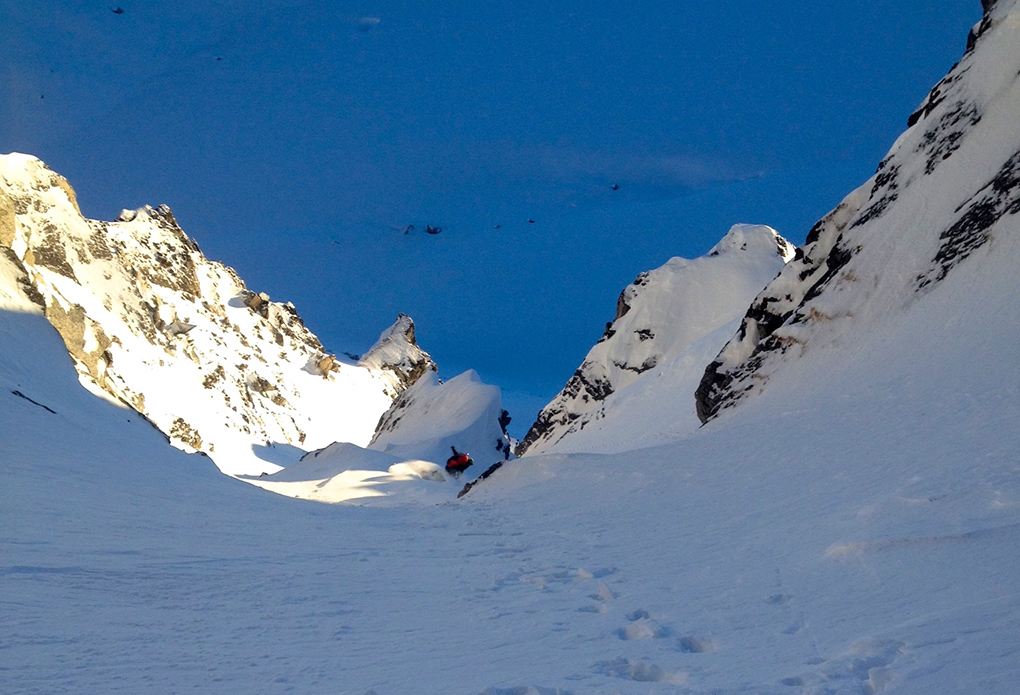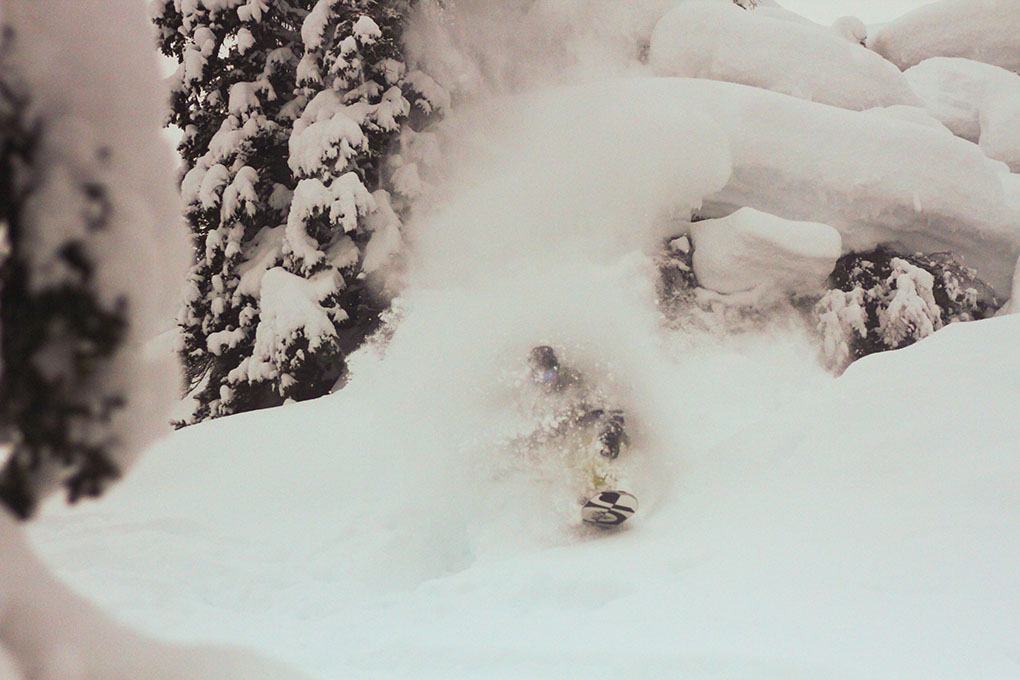Transition / Board Interface
Compared to any other splitboard binding I have used, the Prime Carbon is unrivaled in transitioning from ride mode to touring, as the binding can remain on the boot and disengages from the board with a quick flip of the Power Link locking mechanism.
Once the board is split, the ski halves can quickly be attached by simply placing the toe of the binding into the touring mechanism and stepping down.
This feature helps significantly in cutting transition times, which often plague splitboarders. The same system can be applied to Verts snowshoes, with the Karakorams Vert adapters, minimizing exposure time when booting up steep terrain.
The board interface is very minimal and easily adjusted. Although initially skeptical of the interface icing up and becoming problematic, I have not had any outstanding issues that could not be resolved by clearing snow and ice with a ski pole tip. The interface is much cleaner than the plastic pucks used by Spark and Voile, and thus results in less snow and ice buildup while touring.
Riding
Riding performance is one of the most critical aspects of any splitboard binding, and the Prime Carbons do not disappoint here. Unlike some splitboard bindings, the Prime Carbons really pull the board together with the Power Link lever.
This pressure is so significant that any ice built up along the inner edge can pop out when the Power link is locked. Although every splitboard manufacturer has a different degree of board gap when assembled, I feel that the Prime Carbon can alleviate most issues when mounted properly.
The rigidity and responsiveness of the carbon highback is unsurpassed, which was much appreciated when riding steep, hard snow, specifically while snowboard-mountaineering. (While spending a month in the Alaska Range touring along the Pika, Kahiltna, and Ruth glaciers, I frequently encountered sketchy riding on bulletproof ice.)

The heel edge of a snowboard can be the achilles heel of the sport. On steep, hard snow over 50 degrees, the heel of the boot, if even slightly overhanging the board, can act like a lever to pry the edge contact off the snow, resulting in a slide along the heel of the boot and loss of control.
While riding down a 50+ degree icy couloir on the Hobbit King (Pika glacier) with the Spark R&D Blaze, a heel edge turn quickly popped me away from the slope resulting in a terrifying 400+ foot slide before I could self arrest. Since that trip, I have experimented with and concluded that a stiffer highback with more forward lean can significantly reduce the chance of taking a heel side fall on steep, hard terrain—a must for anyone riding with exposure.
The impressive performance and responsiveness of the Prime Carbons was also evidenced while tree riding, enjoying deep powder days, and with more freestyle-oriented riding. The stiffer binding allows for quick snappy turns when in tight terrain, or can be slowly loaded for larger, explosive carves. I have not found that the stiffness has negatively affected the bindings performance while slashing turns or tweaking grabs when riding more playful terrain.

Durability
One of my biggest concerns with the Prime Carbon is the durability of the system, as there are many moving intricate parts and levers. Although the problems I have encountered have not been a result of the Power Link lever, I can imagine this being a weak point after several seasons.
During roughly 50 days of use, I had three major failures: (1) the collapsing heel lifts, (2) lateral play in the toe bracket and (3) a snapped carbon fiber highback.
The most catastrophic failure of the Prime Carbons so far is the broken highback. The break occurred while launching off of a pillowed tree and landing slightly nose heavy, resulting in a minor tomahawk. Performance-wise, I was unaware of the break until I stepped out of the binding and noticed a full break along the front connection point of the binding. Even with the broken highback, I was able to enjoy several more runs before returning to the car.

After speaking with Karakoram customer service, I was informed that the failure was most likely a result of an air bubble in the resin since this was only the second broken highback they have seen in the company’s history. Within 24 hours of contacting customer service, a replacement was in the mail, free of charge. Despite the break, I feel confident that the highbacks should be able to withstand years of abuse.
After 6 days on the bindings, while touring to a remote hut, both heel lifts failed. The problem lies in a plastic catch that rubs against metal. After several days the rivets that keep the heel riser upright became very loose resulting in a butterfly type failure… the high heel lift would collapse towards the nose of the board and the lower heel lift would flatten towards the tail of the board. I was able to limp to the hut by tapping the lower heel lift into position with my ski pole every 20-30 steps, which was extremely frustrating over the course of 9 miles and several thousand feet of vertical gain.
The problem seemed to occur when the binding was flexed torsionally while side hilling. After contacting Karakoram I immediately received two sets of replacements, and was on my way again. The replacements lasted for another 25-30 days of use, then failed once again on a week long trip to Thompson Pass, Valdez.
The persistent failure was most notable while kick turning along a steep skin track. During the trip, significant lateral play of 4-5mm was noted in one of the toe brackets, furthering the heel riser issues. In addition, the levers in the toe bracket appeared to be quite loose, and I was unable to tighten them due to the construction utilizing rivets.
Once again, I experienced excellent customer service and a very timely replacement. Although the failures were not catastrophic and the parts were replaced, my confidence in the bindings was compromised, and I don’t leave the parking lot now without a spare heel riser.
Bottom Line
The Karakoram Prime Carbon binding outperforms any splitboard binding I have used, both on the ascent and descent, and in any terrain.
The bindings are extremely light and contain well thought out features for performance and efficiency. Although I found certain aspects of the binding to be prone to failure (especially the heel lifts), I feel strongly that these are the best-performing splitboard binding currently available. However, if you prioritize durability and longevity over performance, then a Spark R&D binding may be a better choice.
